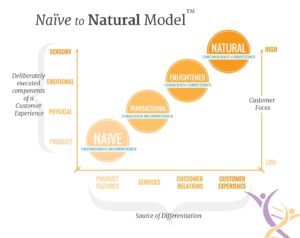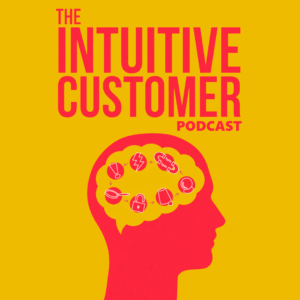When I started Beyond Philosophy back in 2002, I could ascertain whether a company was customer-focused or not right away. I wondered how I did that. When I thought about it, there were some common telltale cultural signs organizations share that indicate where their focus lies.
This answer became my second book, Revolutionize Your Customer Experience, which explores how the culture of a company reflects how customer-centric the organization is. It is also where I first shared the Native to Natural™ model.

The Naïve to Natural Model classifies organizations into four orientations, which I called Naive, Transactional, Enlightened, and Natural. Naive organizations are the least customer-focused, looking inside at operations rather than out to customers. Natural companies are the opposite; they are “naturally” focused on the customer. Transactional and Enlightened are somewhere in between the two extremes.
We shared some examples of some of the indicators of whether a company is customer-centric or not customer-centric on a recent podcast. The signs reveal themselves best as answers to questions.
To that end, here are seven essential questions you should ask yourself about your organization to determine how customer-centric your company is:
How Customer-Centric is Your Organization?
- Where does the customer get put on your agenda? When you’re having your regular management meetings, where are the Customer Experience and the customer stats listed on the schedule? Is it in there at all? Is it at the top or the end? Where you discuss customers on the agenda reflects whether the organization prioritizes them.
- What measurement is in place? In other words, when you talk about measurement, are you instead talking about productivity? For example, often, the call center environment has a measure called “Average Call-Handling Time.” In other words, how long was the representative talking to the customer? Typically, it is just under two minutes or so. However, Average Call Handling Time is not a customer measure; it’s a productivity measure. Moreover, the problem with measuring call handling time pushes agents to close the call and push the customer off the line, which isn’t a great Customer Experience. Measurements should be accurate customer measures, like Customer Satisfaction scores or Net Promoter Scores® (NPS)[1], a measure of how likely that customer is to recommend you to others.
- Do you over-emphasize cost-cutting measures and under-emphasize the effect it will have on Customer Experience? Cost-cutting is a reality of running a business. However, the detrimental impact it can have on the Customer Experience is a reality also. I don’t have a problem with people cutting costs; people are in business to make money, after all. Where companies get into trouble is failing to acknowledge the tradeoff. When you cut personnel or make changes to production to reduce your costs in the short term, there is a good chance that your Customer Experience will not be as good in the long-term. Ensure that you take that into account when you make these decisions.
- Are you too focused on sales revenue? When mobile phone companies were recruiting customers in the beginning, they focused on bringing people on board, signing them up for service. However, once the market reached its saturation point, the companies realized they were losing customers pretty fast (called churn). It wasn’t until they recognized the churn that was happening that mobile companies considered their Customer Experience. They weren’t strategic about it. Customer Experience is not only about acquisition; it’s also about retention. Retention is also crucial because it costs far less to keep a customer than it does to acquire a customer. So being too focused on revenue and not on Customer Experience is a telltale sign of a different focus than customers.
- How do people talk about customers at the organization? In our Global Customer Experience Consultancy, we were doing some work with an airline. This airline didn’t call customers passengers. They called them self-loading freight. It was a joke, of course, but it also shows the mentality of the company and their perception of customers. Also, do you spend more time talking about “processes” or “experiences.” A significant difference exists between a process and an experience. A process is the steps. Customer Experience is a lot more than steps.
- How much time do senior and middle managers spend talking to customers? Too often, the top team doesn’t interact with customers. Sometimes, the only time senior management ever deals with customers is when there is a significant sale on the line. The direct contact between senior management and customers is essential, however. One of the best practices I ever saw in an organization was having the top team deal with customer complaints. The managers phoned the customer directly, discussed the problem, and then, after fixing the situation with the customer, dealt with what’s happening in the organization that caused the complaint in the first place.
- What sacrifices is the organization making for the customer? We make sacrifices all the time for people we care about. When your kids or significant other asks you for help and you have to sacrifice something to do it, you do in many cases depending on the circumstances. Sometimes organizations do the same for customers. Customer-focused organizations, or Natural organizations, make them because they know it is worthwhile for the customer relationship. Transactional organizations and naive organizations might not.
Upon review, this list of questions concerns areas that are both tactical and practical. However, the answers to them reveal issues that occur at a cultural level.
If the meeting agenda has Customer Experience at the end, when some people leave to catch a flight, it shows how the culture values the customer work in their overall plans.
When senior management never interacts with customers, it shows that they don’t prioritize customers at their level.
If the idea of sacrificing anything from the bottom line to satisfy a customer sounds ridiculous to an organization, then that speaks to how much value they assign to a customer ($0).
These questions reveal the telltale signs that show where the organization is right now on customer focus. The next step after answering them is to determine where you want the organization to be.
If upon answering these questions, you are happy where you are, you should carry on doing what you’re doing. However, if you are not, you can only improve the customer’s experience sustainably if you address these issues. If you don’t address these more long-term strategic cultural issues, then you will not improve the Customer Experience.
It reminds me of a utility company for whom we conducted an introductory training on Customer Experience. There were around 20 people there, and one of them was a young lady who had just joined the company. She was very engaged in the training. She made a lot of suggestions to the group about how they could change things to improve the Customer Experience. However, the other members of the team who had been there longer kept coming back with things like, “No, we did that 20 years ago, and it didn’t work,” or “We tried that last year.”
You could see them beating the enthusiasm right out of her. It reminds me of the Star Trek Borg, which said, “Resistance is futile.” If you sense that your organization has a culture promoting that resistance is futile, it might not be the right organization for someone who wants to focus on the customer.
Culture is vital to Customer Experience and has an enormous influence on how your people prioritize customers. Signals from management and fellow employees will do more to improve your Customer Experience than a set of rigorous metrics reviewed at the weekly meeting. The messages they send can also stop your progress before you get started.
What signals does your culture send?

Hear the rest of the conversation on Telltale Signs of a Company Not Committed to Customers on The Intuitive Customer Podcast. These informative podcasts are designed to expand on the psychological ideas behind understanding customer behavior. To listen in, please click here.
If you enjoyed this post, you might be interested in the following blogs and podcasts:
How Do Customers Decide If Their Experience is Good or Bad? [Podcast]
How We Make Decisions—Prospect Theory
Why Customers Make Strange Decisions
Colin Shaw is the founder and CEO of Beyond Philosophy, one of the world’s leading Customer experience consultancy & training organizations. Colin is an international author of six bestselling books and an engaging keynote speaker.
Follow Colin Shaw on Twitter @ColinShaw_CX
[1] Net Promoter, Net Promoter System, Net Promoter Score, NPS, and the NPS-related emoticons are registered trademarks of Bain & Company, Inc., Fred Reichheld and Satmetrix Systems, Inc


